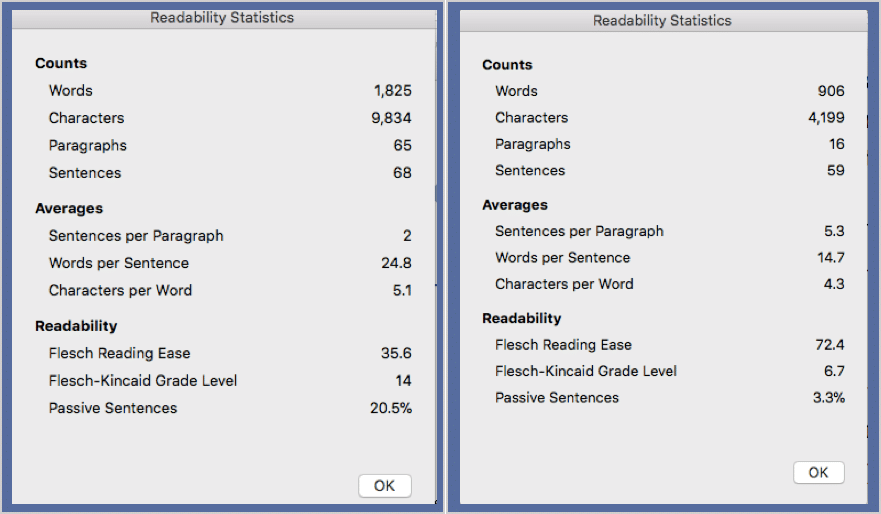Yesterday, I was asked to edit a fundraising case for a client. What is usually an easy task for me was instead surprisingly complicated. I kept finding myself reading and re-reading sentences to try to understand the point. I was thrown off by words and acronyms that were either jargon or obscure uses highly sophisticated words. It was a mess.
It was clear the writer was straining to sound impressive by using long sentences and big words. These efforts were attempted at the expense of clarity though. The author chose sounding smart versus being understood.
Like most writing, fundraising writing is best when it is simple and clear. Rarely do I have the time, attention span, or interest to fight through something that looks like War and Peace or a section of tax code. Donors are the same way; if it is not easy, they move on.
There is a simple way to check your writing to ensure it is more accessible to readers. Microsoft Office offers “Readability Statistics” in both Word and Outlook. With just a simple check, you can know if you are in the ballpark. Click this link to run Readability Statistics on your writing.
Here are two examples of readability reports:

The first came from the fundraising case I was asked to edit. The second report is from my Little Red Wagon blog on donor stewardship. There are three scores that I pay attention to in this report: 1) Words Per Sentence, 2) Flesch-Kincaid Grade Level, and 3) Passive Sentences.
Let’s start with grade level. The grade level loosely corresponds with our American grade levels in school. Thus, a 4.2 indicates a fourth-grade reading level and a 13.4 indicates a freshman in college reading level. For donor writing, I encourage my clients to aim for between a 6th and 9th grade. This range offers sufficient detail to engage the reader yet is easy to read for most. Anything over 10 or 11 is too high for most donor groups. Even highly educated populations prefer to read in the 6-9 range. The reading level is calculated based on the “average syllables per word” and “average words per sentence.”
Reducing long sentences is a great way to reduce reading level (again a good thing). Long sentences are hard to read. Thus, an easy way to make your writing more accessible is to break up long sentences. An average of 12 to 18 words per sentence is a great range to shoot for. Hitting that range will help your donors read about the great work of your organization.
Finally, unless you are Yoda, the passive voice you should avoid. While endearing for Yoda, sentences written in passive voice are often longer, awkward, and more confusing. Instead, write sentences in active voice where the subject performs the action of the verb. The Readability Statistics do an imperfect job of catching passive voice; however, it will identify the most obvious examples. 20.5% of our client’s sentences were passive; this dramatically reduced readability. I try to keep passive voice at no more than 5%. Here is a very helpful resource from the Purdue Online Writing Lab on passive vs. active voice.
Your writing may not have these writing problems. However, I encourage you to run readability statistics from time to time to double check. Your donors will thank you!
Fundraising lacking punch? DB&A partners with clients to bring life back into fundraising programs and revenue back into budgets! Call us today to learn more.


